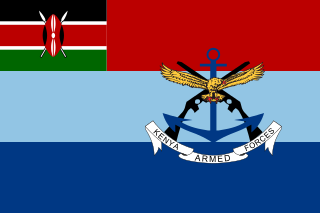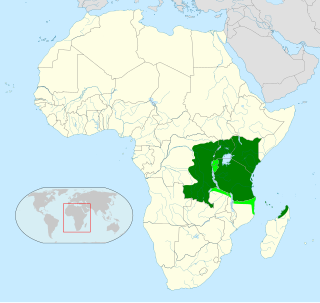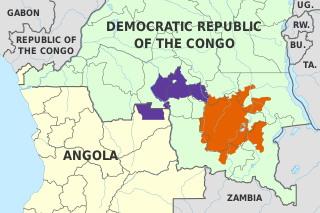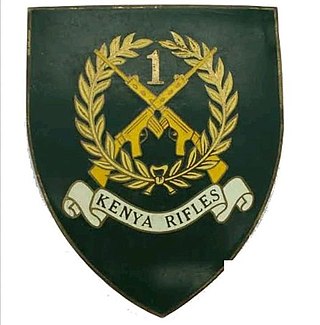Related Research Articles

The Bantu languages are a language family of about 600 languages that are spoken by the Bantu peoples of Central, Southern, Eastern and Southeast Africa. They form the largest branch of the Southern Bantoid languages.

The Kenya Defence Forces (KDF) are the armed forces of the Republic of Kenya. They are made up of the Kenya Army, Kenya Navy, and Kenya Air Force. The current KDF was established, and its composition stipulated, in Article 241 of the 2010 Constitution of Kenya; it is governed by the KDF Act of 2012. Its main mission is the defence and protection of the sovereignty and territorial integrity of Kenya, recruitment to the KDF is done on yearly basis. The President of Kenya is the commander-in-chief of the KDF, and the Chief of Defence Forces is the highest-ranking military officer, and the principal military adviser to the President of Kenya.
A pidgin, or pidgin language, is a grammatically simplified means of communication that develops between two or more groups of people that do not have a language in common: typically, its vocabulary and grammar are limited and often drawn from several languages. It is most commonly employed in situations such as trade, or where both groups speak languages different from the language of the country in which they reside. Linguists do not typically consider pidgins as full or complete languages.

Swahili, also known by its local name Kiswahili, is a Bantu language spoken by the Swahili people, who are found primarily in Tanzania, Kenya and Mozambique.

Luba-Kasai, also known as Cilubà or Tshilubà, Luba-Lulua, is a Bantu language of Central Africa and a national language of the Democratic Republic of the Congo, alongside Lingala, Swahili, and Kikongo ya leta.

The King's African Rifles (KAR) was a British Colonial Auxiliary Forces regiment raised from Britain's East African colonies in 1902. It primarily carried out internal security duties within these colonies along with military service elsewhere during the world wars and other conflicts, such as the Malayan Emergency and the Mau Mau uprising. The regiment's enlisted soldiers were drawn from the native Africans, while most officers were seconded from the British Army. During the 1960s, as part of the decolonisation of Africa, more African officers were commissioned into the regiment before it was gradually disbanded. KAR battalions would go on to form the core of newly established armed forces throughout East Africa.
Sheng is a Swahili and English-based cant, perhaps a mixed language or creole, originating among the urban youth of Nairobi, Kenya, and influenced by many of the languages spoken there. While primarily a language of urban youths, it has spread across social classes and geographically to neighbouring Tanzania and Uganda.
Soga, or Lusoga, is a Bantu language spoken by the Soga people of the Busoga region in Eastern Uganda. With over three million speakers, it is one of the major languages of Uganda, after English, Swahili, and Luganda. However, it is largely restricted to the Busoga region, which is mainly within the natural boundaries of Lake Victoria to the south, Lake Kyoga to the north, the Nile river to the west and the Mpologoma ('Lion') river to the east of Namutumba district. It is tonal.
Kisuba, also known as Olusuba, is a Bantu language spoken by the Suba people of Kenya. The language features an extensive noun-classification system using prefixes that address gender and number. Suba clans are located on the eastern shore and islands of Lake Victoria in Kenya and Tanzania. They have formed alliances with neighboring clans, such as the Luo people, via intermarriages, and as a result a majority of Suba people are bilingual in Dholuo. The Suba religion has an ancient polytheistic history that includes writings of diverse, ancestral spirits. A recent revival of the Suba language and its culture has influenced the increasing number of native speakers each year.
The Nubi language is a Sudanese Arabic-based creole language spoken in Uganda around Bombo, and in Kenya around Kibera, by the Ugandan Nubians, many of whom are descendants of Emin Pasha's Sudanese soldiers who were settled there by the British colonial administration. It was spoken by about 15,000 people in Uganda in 1991, and an estimated 10,000 in Kenya; another source estimates about 50,000 speakers as of 2001. 90% of the lexicon derives from Arabic, but the grammar has been simplified, as has the sound system. Nairobi has the greatest concentration of Nubi speakers. Nubi has the prefixing, suffixing and compounding processes also present in Arabic.
The Gusii language is a Bantu language spoken in Kisii and Nyamira counties in Nyanza Kenya, whose headquarters is Kisii Town,. It is spoken natively by 2.2 million people, mostly among the Abagusii. Ekegusii has only two dialects: The Rogoro and Maate dialects. Phonologically they differ in the articulation of /t/. Most of the variations existing between the two dialects are lexical. The two dialects can refer to the same object or thing using different terms. An example of this is the word for cat. While one dialect calls a cat ekemoni, the other calls it ekebusi. Another illustrating example can be found in the word for sandals. While the Rogoro word for sandals is chidiripasi, the Maate dialect word is chitaratara. Many more lexical differences manifest in the language. The Maate dialect is spoken in Tabaka and Bogirango. Most of the other regions use the Rogoro dialect, which is also the standard dialect of Ekegusii.
The Koti language, or Ekoti, is a Bantu language spoken in Mozambique by about 64,200 people. Koti is spoken on Koti Island and is also the major language of Angoche, the capital of the district with the same name in the province of Nampula.
In linguistics, the term nominal refers to a category used to group together nouns and adjectives based on shared properties. The motivation for nominal grouping is that in many languages nouns and adjectives share a number of morphological and syntactic properties. The systems used in such languages to show agreement can be classified broadly as gender systems, noun class systems or case marking, classifier systems, and mixed systems. Typically an affix related to the noun appears attached to the other parts of speech within a sentence to create agreement. Such morphological agreement usually occurs in parts within the noun phrase, such as determiners and adjectives. Languages with overt nominal agreement vary in how and to what extent agreement is required.

The Ovambo language is a dialect cluster spoken by the Ovambo people in southern Angola and northern Namibia, of which the written standards are Kwanyama and Ndonga.
The Sabaki languages are the Bantu languages of the Swahili Coast, named for the Sabaki River. Sabaki is a Pokomo word for Large Fish. In addition to Swahili, Sabaki languages include Ilwana (Malakote) and Pokomo on the Tana River in Kenya, Mijikenda, spoken on the Kenyan coast; Comorian, in the Comoro Islands; and Mwani, spoken in northern Mozambique. In Guthrie's geographic classification, Swahili is in Bantu zone G, whereas the other Sabaki languages are in zone E70, commonly under the name Nyika.
Rangi or Langi is a Bantu language spoken by the Rangi people of Kondoa District in the Dodoma Region of Central Tanzania. Whilst the language is known as Rangi in English and Kirangi in the dominant Swahili spoken throughout the African Great Lakes, the self-referent term is Kilaangi.

The units of the Kenya Army Infantry are the principal fighting arms of the Kenya Army. The primary mission of the Infantry formations is to fight and win land battles within area of operational responsibilities in the defence of the nation against land – based aggression, while the secondary mission is the provision of aid and support to civil authorities in the maintenance of order. The Kenyan School of Infantry (SOI) is located in Isiolo County.

1st Kenya Rifles is an infantry battalion of the Kenya Army. It is a descendant of the pre-independence Kenya British Army formation the Kings African Rifles that was formed before the First World War.
Settla, or Settler Swahili, is a Swahili pidgin mainly spoken in large European settlements in Kenya and Zambia. It was used mainly by native English speaking European colonists for communication with the native Swahili speakers.
Kenyan English is a local dialect of the English language spoken by several communities and individuals in Kenya, and among some Kenyan expatriates in other countries. The dialect contains features unique to it that were derived from local Bantu languages, such as Swahili.
References
- 1 2 Jouni Filip Maho, 2009. New Updated Guthrie List Online
- 1 2 3 4 5 6 7 Mutonya, Mungai; Parsons, Timothy H (2004). "KiKAR: a Swahili variety in Kenya's colonial army" (PDF). Journal of African Languages and Linguistics. Walter de Gruyter. 25 (2): 111–125. doi:10.1515/jall.2004.25.2.111. S2CID 54535559.